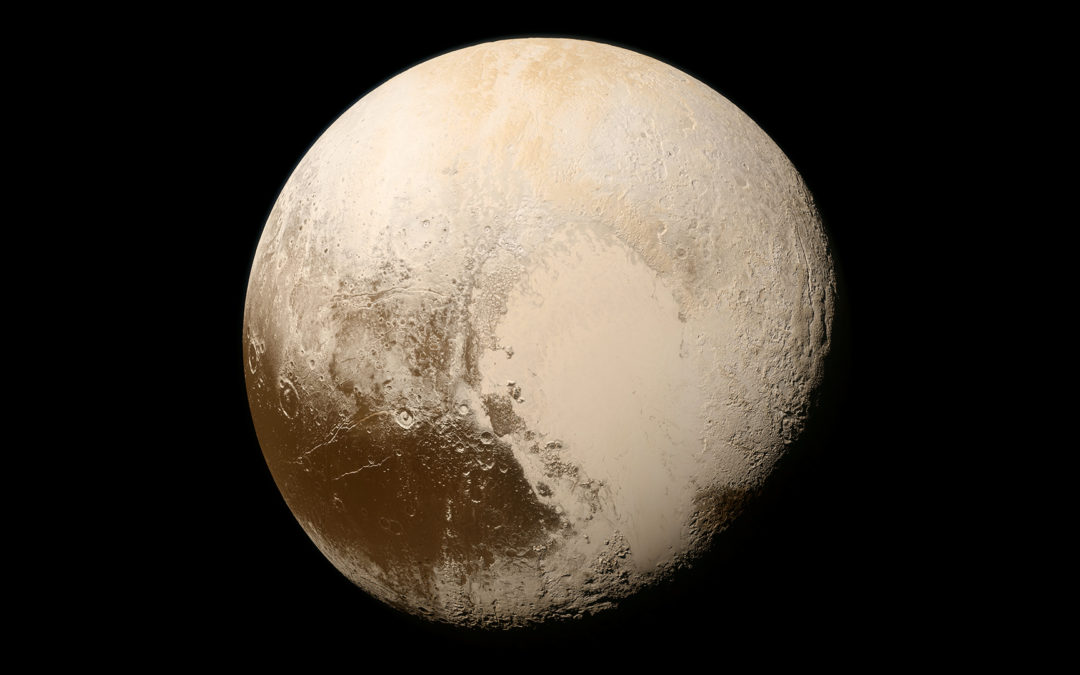When Pluto was discovered in 1930, it was immediately accepted as the ninth planet. Seventy-six years later, the International Astronomical Union decided that Pluto should no longer be considered a planet, and reclassified it as a “dwarf planet.”[1] What motivated this reclassification? And how exactly is a planet defined? Regardless of how we choose to classify it, Pluto is a wonderful creation and one that does not fit the secular narrative. The discovery and early investigation of this dwarf planet is a fascinating part of history.
Discovery
The discovery of Neptune was a triumph of Newtonian physics. Le Verrier and Adams successfully predicted the position of the as-yet-undetected planet due to its slight gravitational pull on Uranus. By the late 1800s some astronomers suspected that Neptune was insufficient to fully explain the motion of Uranus. They supposed that there was yet another planet in the outer solar system.
The search for this hypothetical “Planet X” began in earnest in 1906, spearheaded by Percival Lowell. Lowell had founded an observatory in Flagstaff Arizona in 1894, and it was at Lowell Observatory that Pluto would be discovered. But the search took many years. At this time in history, photographic film had taken the place of hand-drawn sketches. This vastly improved the accuracy of star charts. It also allowed astronomers to continue their search during the day, analyzing photographs that had been captured at night.
Lowell attempted to calculate the position of Planet X just as Le Verrier and Adams had predicted the position of Neptune before it was observationally confirmed. Unfortunately, the position predicted by Lowell revealed no planet. Lowell widened his search, which he continued until his death in 1916.
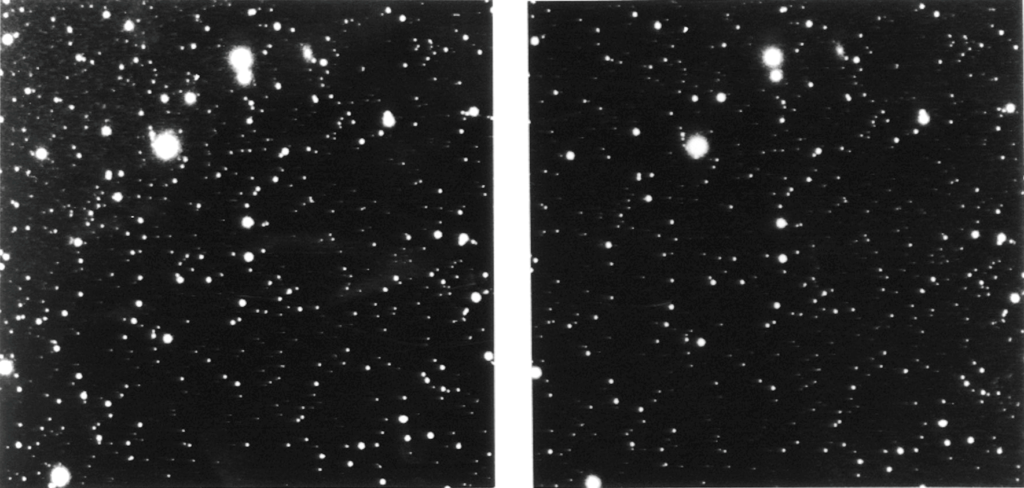
In 1929, Clyde Tombaugh resumed the search for Planet X. If another world existed beyond Neptune, it was obviously small and faint – indistinguishable from background stars. The only way to find such an object was by its motion. Stars remain stationary relative to each other, but planets orbit the sun. So, by comparing two photographs of a section of the night sky taken at two different dates, a planet can be detected because it will appear in a different position relative to the background stars. But a typical image might contain thousands of stars. Recognizing the one that moved can be challenging. In fact, the two images above are the actual photographs in which Pluto was discovered. Can you detect which “star” moved?
So, Tombaugh used a device to make this task easier: a blink comparator. This device allows the observer to rapidly switch two photographs of the same section of the sky taken at different dates. The human brain has a remarkable ability to detect a sudden change. And so, by rapidly switching back and forth between the two images, we can more easily discover the one point that appears to jump back and forth. The animated image below flips between the two photographs above on which Pluto was discovered. Pluto is the faint blip that jumps left-right near the center of the frame. This is essentially what Tombaugh saw when he discovered Pluto in 1930.

News of this discovery rapidly spread around the world and suggestions on what to name the new world began to pour in. Interestingly, the name “Pluto” was proposed by an eleven-year-old school girl named Venetia Burney.[2] She had an interest in classical mythology, and Pluto was the name of the god of the underworld.[3] It was a fitting name for a dark world so distant from the sun. Members of Lowell Observatory unanimously agreed on the name, which became official on May 1, 1930. The name Pluto also indirectly honors Percival Lowell, in that its first two letters match his initials.
An Unusual Orbit
Pluto orbits the sun at an average distance of 3.6 billion miles. This is 39 times farther than Earth orbits, and farther than any of the other planets. The sun would appear 1560 times fainter than it does on Earth. At such a distance Pluto takes 248 years to orbit the sun. So, it has not made even one orbit since its discovery, and will not do so until the year 2178. It has orbited the sun only 24 times since creation.
Pluto’s orbit is different from the classical eight planets in two ways. First, it has a rather high inclination. The eight planets orbit very nearly in the same plane: the ecliptic. But Pluto’s orbit is tilted by 17 degrees relative to the ecliptic.

Second, Pluto’s orbit has a much higher eccentricity. Eccentricity refers to the “squashedness” of an ellipse. Most planets have an eccentricity close to zero, meaning their orbit is nearly circular. A closed orbit cannot exceed an eccentricity of 1. Pluto’s eccentricity is 0.2488. For comparison, the eccentricity of Earth’s orbit is only 0.017.
The high eccentricity of Pluto’s orbit brings it closest to the sun (perihelion) at a distance of 2.76 billion miles, and its farthest point (aphelion) is 4.58 billion miles. Recall that Neptune orbits at a distance of 2.79 billion miles. So, when Pluto is near perihelion, it is actually closer to the sun than Neptune. This was the case from 1979 to 1999.
Could Pluto ever collide with Neptune? After all, overhead views of the solar system show two points where Pluto’s orbit apparently crosses Neptune’s orbit. But a collision (or even a close pass) can never occur for two reasons. First, the two orbits do not actually intersect because they are in different planes. The overhead view obscures the fact that Pluto’s orbit is substantially tilted relative to that of Neptune, and the apparent points of intersection are actually separated vertically by millions of miles.
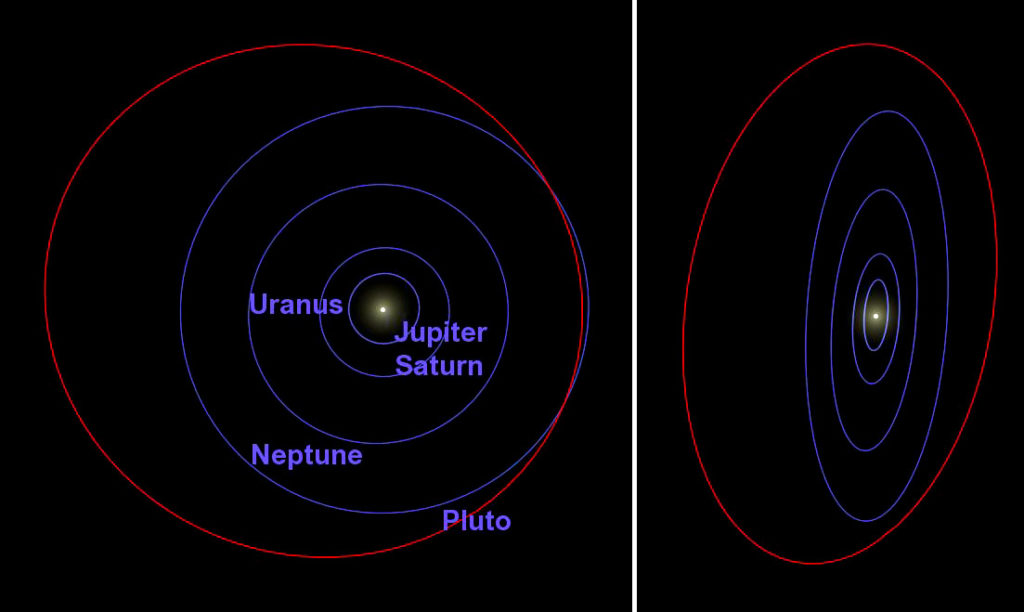
Second, Pluto is in a 2:3 orbital resonance with Neptune. That is, Pluto orbits the sun twice in the time it takes Neptune to orbit three times. Consequently, when Pluto is at perihelion, Neptune can only be at one of two possible locations along its orbit. The synchronized nature of their orbits is very stable and ensures that Neptune never comes dangerously close to Pluto.
It’s a Small World After All
Pluto can be detected in a backyard telescope under extremely dark skies, but it is challenging. Unless you have exceptional vision, a 10-inch or larger telescope is required. And Pluto will be indistinguishable from a star. The only way to know you are looking at Pluto and not a star is to compare the view with star charts of the area and look for the blip that doesn’t belong. Indeed, even the largest ground-based telescopes of the 20th century were unable to detect any substantial size for Pluto. Its mass was also unknown. The only thing astronomers knew for certain was that Pluto is very small – much smaller than any of the other outer planets.
Initially many astronomers assumed that Pluto might be as massive as Earth. But this estimate was vastly inflated, and perhaps largely driven by the assumption that Lowell was correct in his assessment of the gravity of Pluto affecting the orbit of Uranus. Later estimates showed that Pluto was smaller than Earth. An estimate in 1950 using the 200-inch telescope at Mount Palomar gave a diameter of 3700 miles, which is smaller than Mars. But even this estimate was inflated.
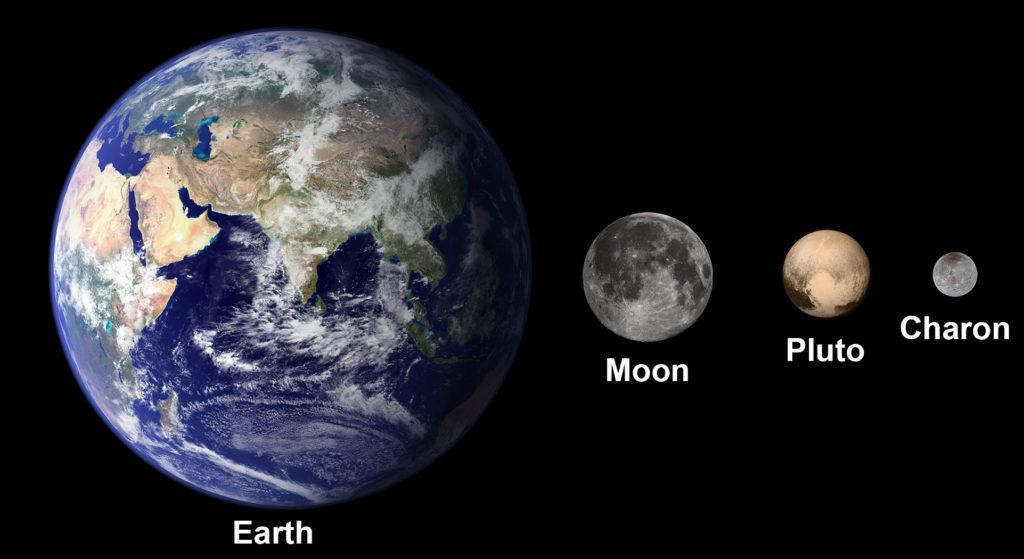
In fact, Pluto is only 1476.8 miles in diameter, which is about 2/3 the size of Earth’s moon, and less than half the size of Mercury. Its diminutive nature is undoubtedly part of the reason it was reclassified in 2006. The 1978 discovery of Pluto’s largest moon, Charon, allowed astronomers to pin down the mass of Pluto very precisely.[4] Pluto is only 0.2% the mass of Earth! Such low mass means that Pluto’s meager gravitational pull cannot possibly have any substantial effect on the orbit of Uranus. It now appears that discrepancies in the orbit of Uranus reported in the early 20th century were due to an incorrect estimate of the mass of Neptune. When Neptune’s correct mass is used, the observed orbit of Uranus matches the predictions. The discovery of Pluto in a region of the sky not all that far from Lowell’s prediction turns out to be merely a coincidence.
Moons and Surface Details
Part of the reason that early estimates of Pluto were too large is that Pluto is orbited by a moon half its size – Charon.[5] The name Charon comes from the Greek/Roman mythological spirit that escorts the souls across the river Styx to the underworld. So it is a fitting companion for Pluto. This moon was discovered in 1978 by James Christy.[6]
There is a practical limit to magnification on Earth-based telescopes due to atmospheric turbulence. So, zooming in on Pluto shows only a larger blur, and no distinct disk. But Christy noticed that some of these images of Pluto going back to 1965 show a “bump” on this blur. This bump had a very regular period of 6 days, 9 hours, 17 minutes. So Christy reasoned that this was an orbiting moon. This was proved beyond all doubt in the late 1980s when Charon and Pluto began a period of mutual eclipses, as discussed below.

Like all large moons, Charon is tidally locked; its rotation matches its orbital period and so it keeps the same side pointed toward Pluto at all times. But unlike any of the classical planets, Pluto is also tidally locked with Charon. That is, Pluto’s rotation is also 6 days, 9 hours, 17 minutes, and keeps the same hemisphere pointed at Charon at all times. Moreover, Charon is half the size of Pluto, and twelve percent of its mass. So it exerts a substantial gravitational pull on Pluto. For this reason, both Pluto and Charon orbit around each other – around their common center of mass. This is technically true for all planet-moon systems. However, for all other planetary systems, the center of mass is inside the planet. So the planet moves only slightly. But not Pluto. Pluto and Charon noticeably orbit each other.

Charon is 753 miles in diameter, making it the largest of Pluto’s moons. For nearly thirty years, it was the only known moon of Pluto. In 2005, the Hubble Space Telescope detected two more: Nix and Hydra. They are tiny – a little over 20 miles across. Hubble detected two additional moons: Kerberos and Styx in 2011 and 2012 respectively, which are even smaller. All of Pluto’s moons are regular; they orbit in the plane of its equator and in the same direction that Pluto rotates.
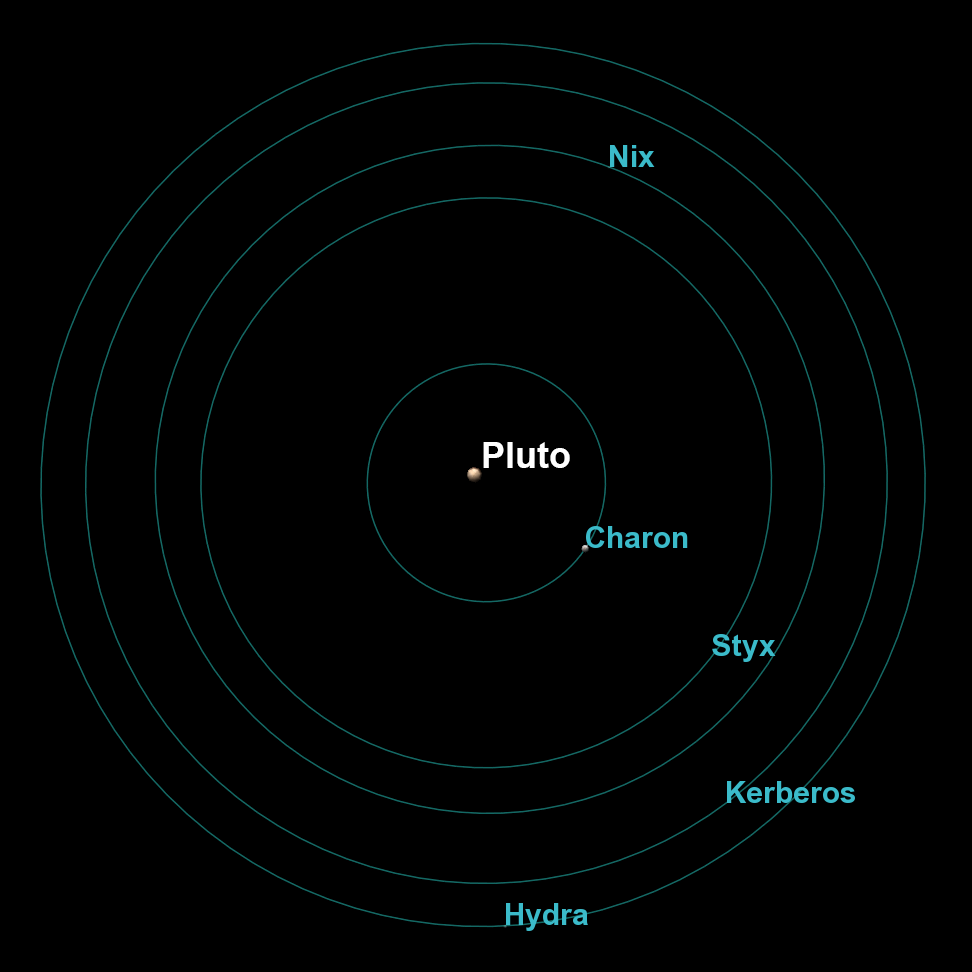
Like Uranus, Pluto rotates on its side. It has an extreme axial tilt: 123 degrees relative to the axis of its orbit (by the right-hand rule).[7] Since its moons orbit around its equator, they too orbit on their side. As Pluto orbits the sun, its rotation axis remains pointed in the same direction. But from our location, we see Pluto from different perspectives. Twice in every orbit of Pluto, we see the Pluto system from its side. This is similar to how Saturn appears edge-on every 15 years, except Pluto’s orbital period is much longer. When this occurs, Pluto’s moons cross directly in front of or beyond Pluto as they orbit. This was the situation from 1985 to 1990. This will not happen again until the early 22nd century.
Astronomers were able to use these mutual eclipses of Pluto and Charon to more precisely pin down the size of each. Although ground-based telescopes cannot clearly distinguish Charon and Pluto, they can measure the total light from both. And when Charon crosses directly in front of Pluto from our perspective, it blocks some of the light from Pluto. This drop in total light is easily detectable in ground-based telescopes. Analysis of these light curves yields the size of both worlds, and even allowed astronomers to create a very approximate map of the surface features on one side of each world.
In the 1990s, the Hubble Space Telescope provided images of Pluto that were far sharper than anything previously obtained from ground-based telescopes. But even in these images, Pluto is tiny and there is only a vague hint of surface details. These were the best images of Pluto available at the time. But they pale in comparison to the glorious images of all the other planets provided by spacecraft flyby missions. But no spacecraft had flown past Pluto. The alignment of the planets allowed Voyager 2 to visit Jupiter, Saturn, Uranus, and Neptune. But Pluto was not aligned with this grand arc. And although Voyager 1 could have been directed to intercept Pluto after its flyby of Saturn, a flyby of Saturn’s moon Titan was considered a higher priority. So the choice to visit Titan disallowed any possibility of a Voyager 1 flyby of Pluto. Although various missions to Pluto were proposed in the 1980s and 1990s, none gained budgetary approval. A spacecraft visit to Pluto would have to wait until the 21st century.
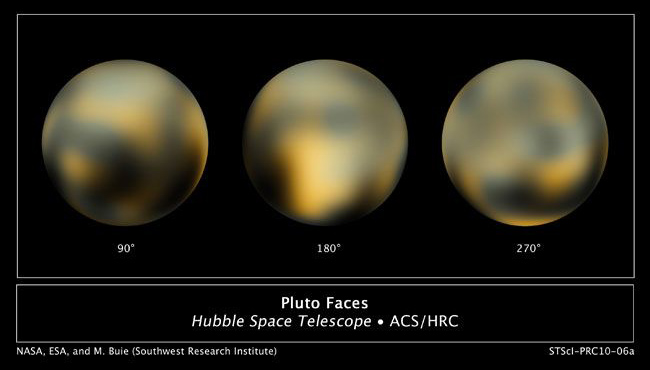
Pluto currently has a very thin nitrogen atmosphere, with smaller quantities of methane and carbon monoxide. The qualifier “currently” is necessary because Pluto only has an atmosphere sometimes. The extremely elliptical orbit of Pluto brings it close enough to the sun for nitrogen to exist in a gaseous state. Pluto therefore has a tenuous atmosphere for several decades surrounding its perihelion passage. However, as Pluto moves away from the sun, dropping temperatures cause its atmosphere to freeze to the surface. One of the motivations for sending a spacecraft to Pluto as soon as possible was to explore the planet while it still has an atmosphere. If we missed that window, we would have to wait nearly 200 years for another opportunity.
Fortunately, the New Horizons mission was approved and funded in the first decade of the 21st century. Launched in 2006, the unmanned spacecraft took nine years to reach Pluto. And it was well worth the wait. The images and data collected by New Horizons were spectacular confirmations of biblical creation. More to come.
[1] “That’s messed up!”
[2] Venetia passed away on April 30, 2009 at the age of 90. So she lived to see Pluto reclassified as a dwarf planet, as well as the 2006 launch of New Horizons – the unmanned spacecraft to visit Pluto.
[3] 1930 was also the year that Walt Disney decided that Mickey Mouse should have a canine companion. When the time came to name the dog, the name Pluto was chosen – apparently in honor of the newly discovered world. The animated dog made his first appearance in “the Chain Gang” in September, 1930.
[4] The orbital period of a moon depends only upon the average distance from its planet (or dwarf planet) and the mass of the planet (or dwarf planet). Hence, by measuring the period of Charon, and measuring its distance from Pluto, the mass of Pluto can be computed using Newton’s version of Kepler’s third law.
[5] The Greek/Roman Charon is pronounced with a hard ‘k’ sound. Consequently, most astronomers pronounce the name this way. The exceptions are those at NASA/JPL who are on the New Horizons team, along with Charon’s discoverer James Christy. They usually prefer the softer pronunciation as in “Sharon.”
[6] James Christy wanted to name this moon of Pluto after his wife Charlene who went by the nickname “Char.” Christy added the “on” as is common in particle physics (electron, proton, positron, etc.) as if this were Char’s moon. Normally, planets and moons are not allowed to be named after living persons, as established by the early attempts to do so with Uranus and Neptune. But when Christy learned that Charon is also the name of a mythological figure, he was able to get around this rule by emphasizing the name’s mythological origin.
[7] By the right-hand rule, Pluto’s north pole points below the plane of the solar system, and the planet rotates prograde. Alternatively, we could take the other pole, the one pointing above the plane of the solar system, as the north pole. By this latter convention, Pluto is tilted only 57 degrees, but rotates retrograde.

